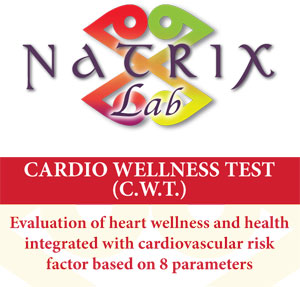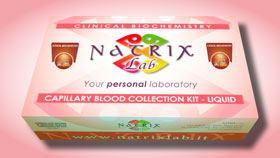What is it and what is it used for?
The Cardio Wellness Test (C.W.T.) is a health indicator for the cardiocirculatory system, and involves evaluating 12 risk parameters, i.e.: LDL Oxidase, Total Cholesterol, HDL Cholesterol, LDL Cholesterol, Triglycerides, Homocysteine, Reactive Protein C, APO A1, APO B, Peptide C, Vitamin D3, Lipoprotein A, Plasmatic fatty acids.
It is used to evaluate potential cardiovascular risk, providing essential data to understand whether your lifestyle and habits (eating and others) put you in risk of pathologies such as hypertension, angina, stroke, cardiac decompensation. This way you can understand what to do to prevent these pathologies occurring. In particular, apart from giving the levels of each single parameter, the test also expresses an evaluation called the absolute cardiovascular risk indicator, expressed as a percentage potential of suffering a major cardiovascular event in the next ten years (infarction or stroke).
Who should take the test?
 We recommend this test if:
We recommend this test if:
- Any family members have suffered major cardiovascular events, and you want to evaluate whether you could develop them.
- If you are overweight and have a bad diet.
- If you are an athlete and want information about how healthy your cardiovascular system is.
- You lead a very stressful life, with little free time and little chance to dedicate to your health.
- You smoke heavily, drink alcohol or coffee.
Where and how to take the test?
The test involves analysing a blood sample, and can be requested in analysis laboratories, medical centres, health spas and pharmacies that offer NatrixLab diagnosis services.
Preparing for the exam: fast for at least 8 hours before the sample is taken.
…and afterwards?
 If the test shows a high indicator of cardiovascular risk, consult your doctor for precise advice and treatment as prescribed. In all events, remember that lifestyle and diet are very important factors to conserve a healthy cardiovascular system. A special diet, perhaps associated with medication prescribed by a specialist, helps reduce the risk of major cardiovascular events, directly working on the metabolic alterations that are behind the pathology.
If the test shows a high indicator of cardiovascular risk, consult your doctor for precise advice and treatment as prescribed. In all events, remember that lifestyle and diet are very important factors to conserve a healthy cardiovascular system. A special diet, perhaps associated with medication prescribed by a specialist, helps reduce the risk of major cardiovascular events, directly working on the metabolic alterations that are behind the pathology.
Repeating the test
We recommend repeating the test after 6 months if:
- The values are still not satisfactory
- You have started medication prescribed by your doctor
- You have changed your lifestyle.
We recommend repeating the test after 12 months if:
- The values are correct and you want prevention to become a way of life
- You want to verify the effectiveness of your medication
Related tests
Related tests
Cellular Aging Factors

The “Cellular Aging Factors” determine the cell aging profile by means of analysing specific biomarkers, which assess the state of four key processes in the organism: methylation, inflammation, glycation and oxidation.
Find out more
Bibliography
- Zebrack JS, Anderson JL, Maycock CA, et al.: Usefulness of highsensitivity C-reactive protein in predicting long-term risk of death or acute myocardial infarction in patients with unstable or stable angina pectoris or acute myocardial infarction. Am J Cardiol 2002; 89: 145–149.
- Dahlen GH, Guyton JR, Attar M, Farmer JA, Kautz JA, Gotto AM: Association of levels of lipoprotein Lp(a), plasma lipids, and other lipoproteins with coronary artery disease documented by angiography. Circulation 1986; 74: 758-65.
- De Lorgeril M, Renaud S, Mamelle N, et al.: Mediterranean alpha-linolenic acid-rich diet in secondary prevention of coronary heart disease. Lancet 1994; 343: 1454-59.
 NatrixLab Laboratorio di analisi – nutrizionista
NatrixLab Laboratorio di analisi – nutrizionista

